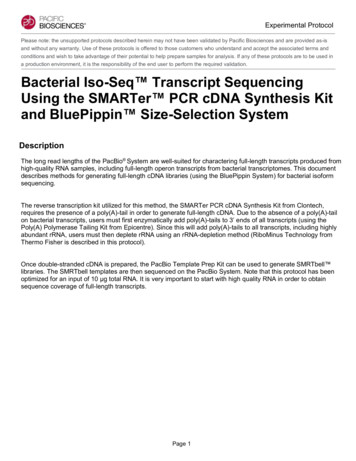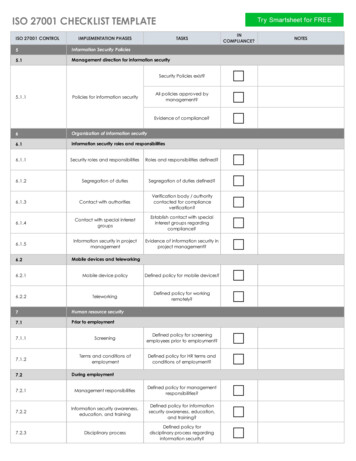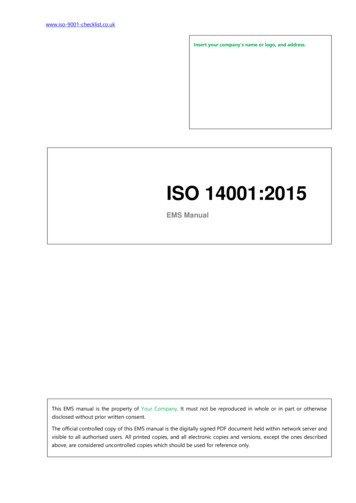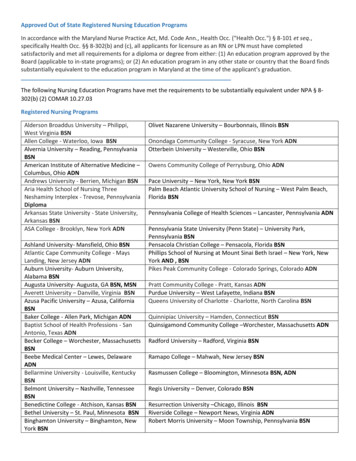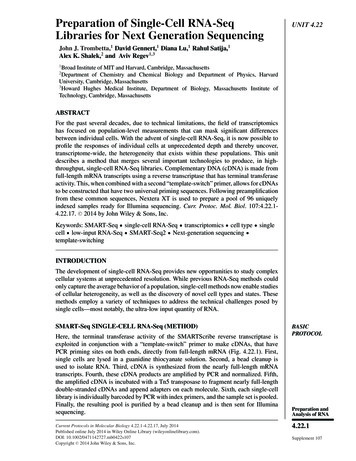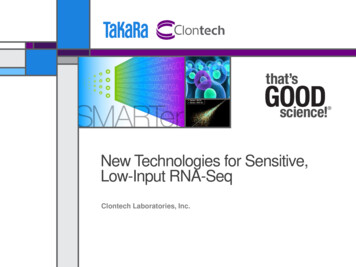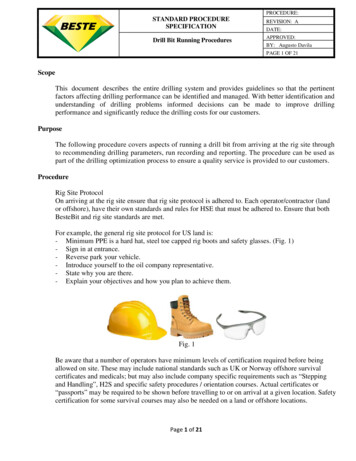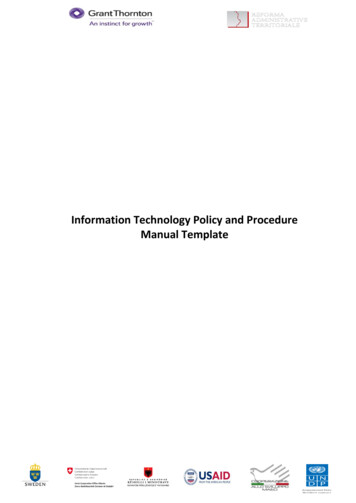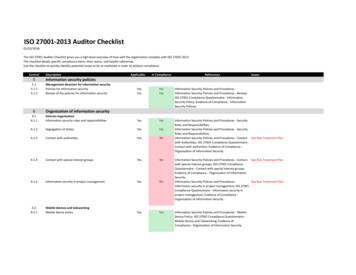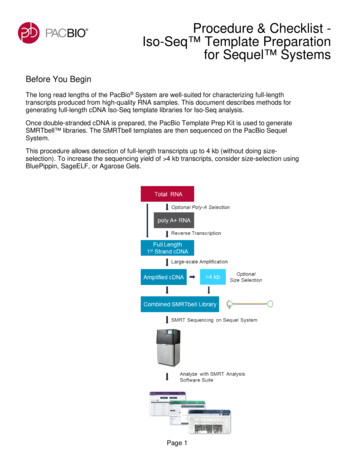
Transcription
Procedure & Checklist Iso-Seq Template Preparationfor Sequel SystemsBefore You BeginThe long read lengths of the PacBio System are well-suited for characterizing full-lengthtranscripts produced from high-quality RNA samples. This document describes methods forgenerating full-length cDNA Iso-Seq template libraries for Iso-Seq analysis.Once double-stranded cDNA is prepared, the PacBio Template Prep Kit is used to generateSMRTbell libraries. The SMRTbell templates are then sequenced on the PacBio SequelSystem.This procedure allows detection of full-length transcripts up to 4 kb (without doing sizeselection). To increase the sequencing yield of 4 kb transcripts, consider size-selection usingBluePippin, SageELF, or Agarose Gels.Page 1
Materials and Kits NeededItemVendorSMARTer PCR cDNA Synthesis KitClontech (634925 or 634926)PrimeSTAR GXL DNA PolymeraseClontech (R050A or R050B)Additional 5’ PCR Primer IIAAny Oligo Synthesis Vendor1.2% FlashGel system or 0.80% Agarose GelsLonza(5702FlashGel DNA Marker (100bp – 3 kb or 100 bp - 4 kb)LonzaQubit dsDNA BR Assay Kit or HS Assay KitInvitrogenDNA 12000 Kit or HS DNA KitAgilentTemplate Prep KitDNA/Polymerase Binding KitPacific BiosciencesDNA Sequencing KitAMPure PBBeadsPreparing cDNA from RNA SamplesFirst-Strand SynthesisFirst strand cDNA synthesis employs the Clontech SMARTer PCR cDNA Synthesis Kit. TheCDS Primer IIA is first annealed to the polyA tail of transcripts, followed by first-strandsynthesis with SMARTScribe Reverse Transcriptase. The first-strand product is diluted withElution Buffer (EB) to an appropriate volume and subsequently used for large-scale PCR. Before proceeding with the first-strand synthesis, determine if one primer annealingand first-strand reaction is enough to proceed to the Test Amplification and LargeScale PCR steps (see dilution table on step 7).Perform additional annealing and first-strand synthesis reactions, if necessary. Ifstarting with total RNA and performing size- selection, we recommend setting upthree separate reactions of first-strand synthesis to ensure there is enough dilutedfirst-strand product for the Test Amplification and Large-Scale PCR steps. If startingwith polyA RNA, one first-strand reaction is sufficient.For each Total RNA sample, combine the reagents below in separate PCR tubes.For poly A RNA, the minimum is 1 ng; total RNA requires 2 ng. We recommend using 1μg oftotal RNA per reaction for optimized results in the following steps.Do not change the volumes of any of the reactions. All components have been optimized forthe volumes specified. If using 1 μg RNA, split the sample into multiple reactions.Page 2
ReagentVolumeRNA (1 ng - 1 μg)Notes1 - 3.5 μL3’ SMART CDS Primer II A (12 μM)1 μLNuclease-Free WaterX4.5 μLTotal Volume1. Mix contents and spin the tubes briefly in a microcentrifuge.2. Incubate the tubes at 72 C in a hot-lid thermal cycler for 3 min; slowly ramp to 42 C at 0.1 C/sec, thenlet sit for 2 minutes. During this step, prepare a Master Mix for all reaction tubes, at room temperature,by combining the following reagents in the order shown. It is important to go immediately into step 4after step 3. However, add the reverse transcriptase to the master mix just prior to use. Mix well bypipetting and spin the tube briefly in a microcentrifuge.ReagentVolumeNotes2 μL5X First-Strand BufferDTT (100 mM)0.25 μLdNTP (10 mM)1 μLSMARTer II A Oligonucleotide (12 μM)1 μL0.25 μLRNase InhibitorSMARTScribe Reverse Transcriptase (100 U) - add before use1 μL5.5 μLTotal Volume added per reaction3. Place the master mix at 42 C for 1 min to bring it up to temperature and proceed immediately to step 4.4. Aliquot 5.5 μL of the Master Mix into each reaction tube. Mix the contents of the tubes by gentlypipetting, and spin the tubes briefly to collect the contents at the bottom.5. Incubate the tubes at 42 C for 90 minutes.6. Terminate the reaction by heating the tubes at 70 C for 10 min.7. Dilute the first-strand reaction product by adding the appropriate volume of PacBio Elution Buffer (EB):Input SampleVolume of EB addedTotal RNA (2 ng - 1 μg)90 μLPolyA RNA, 0.2 μg190 μLPolyA RNA, 0.2 μg90 μLPage 3
If multiple reactions were performed with the same RNA samples, pool the diluted first-strand reactionstogether before the amplification steps.PCR Cycle OptimizationIt is highly recommended to perform cycle optimization to determine the optimal number of cycles (whileminimizing artifacts during large-scale amplification) for large-scale PCR.Test Amplification – we highly recommend performing the below test amplification procedure in order todetermine the best number of cycles required for the sample to minimize artifacts during large-scaleamplification.1. Add the following reagents to an appropriately sized PCR tube:ReagentVolume5X PrimeSTAR GXL buffer10 μLDiluted first-strand cDNA from step 7 above10 μLdNTP Mix (2.5 mM each)4 μL5’ PCR Primer II A (12 μM)1 μL24 μL (sub-total)Nuclease-free waterPrimeSTAR GXL DNA Polymerase (1.25 U/μL)1 μLTotal Volume50 μL2. Cycle the reaction with the following conditions (using a heated lid): Initial denaturation:– 98 C for 30s 10 cycles at the following temperatures and times:– 98 C for 10 seconds– 65 C for 15 seconds– 68 C for 10 minutes Final extension:– 68 C for 5 minutes3. After the initial 10 cycles, remove 5 μL of the reaction and transfer it to a tube labeled “10.”4. Return the remaining 45 μL PCR reaction to the thermocycler and run two cycles of the aboveamplification conditions. 2 cycles at the following temperatures and times:– 98 C for 10 seconds– 65 C for 15 seconds– 68 C for 10 minutes Final extension:– 68 C for 5 minutes5. Remove 5 μL again and transfer to a tube labeled “12.”6. Repeat steps 4-5 for 14 cycles.Note that the number of cycles is dependent on the sample input. Typically, 1 μg input of totalRNA requires 10 to 12 cycles of PCR amplification. When input total RNA is 1 μg, the cyclenumber might need to be increased.7. Load the 3 aliquots on an Agarose gel or Lonza flash Gel to view distribution of the ds cDNA.Page 4Notes
Figure 1 Analysis for optimizing PCR cycles: This sample is Human Brain Total RNA from Biochain. 1ug of starting RNA wasused to set up cDNA synthesis. Gel electrophoresis was performed on a 1.2% Lonza FlashGel. Lane L: Lonza FlashGel Ladder(100 bp – 3 kb). The numbers above the other lanes indicate cycle number. One reaction of 50 µL PCR was set up to obtain thisseries cycle of optimization. In this example, PCR with 10 cycles was determined to be optimal for large-scale amplification.Cycles 8 and 10 look similar in banding and size, however cycle 10 has more products than 8 cycles. In cycles 12 and above, thecDNA smears show over- amplification.Large-Scale PCRUse the cycle number (as determined in the PCR Cycle Optimization step) to generate ds cDNA1. Set up 16 X 50 μL PCR reactions. (Set up 24 X 50 μL PCR reactions if size-selection is required)2. Make a master mix by adding the following reagents:ReagentVolume5X PrimeSTAR GXL Buffer160 μLDiluted first-strand cDNA Synthesis160 μLdNTP Mix (2.5mM each)64 μL5’ PCR Primer II A (12 μM)Nuclease-free waterNotes16 μL384 μL (to 392 μL sub-total)PrimeSTAR GXL DNA Polymerase (1.25 U/μL)16 μLTotal Volume800 μL3.Transfer 50 μL aliquots into 16 PCR tubes and perform PCR using the cycle numberdetermined during the optimization step. Cycle the reaction with the following conditions(using a heated lid) - see step 2 page 5: Initial denaturation:– 98 C for 30 seconds n cycles (optimal cycle determined in the optimization step) at the following temperatures and times:– 98 C for 10 seconds– 65 C for 15 seconds– 68 C for 10 minutes Final extension:– 68 C for 5 minutesPage 5
AMPure PB Bead Purification of Large-Scale PCR ProductsThis step requires two tubes of pooled PCR products that are processed in parallel. The first pool is purifiedusing 1X AMPure PB beads and the second pool is purified using 0.40X AMPure PB beads.STEPPurify the Pooled PCR Products - First Purification1Pool 8 x 50 PCR reactions and add 1X volume of AMPure PB magnetic beads.Label the tube appropriately.2Pool another 8 x 50 PCR reactions and add 0.40X volume of AMPure PB magneticbeads in a separate 1.5mL LoBind tubes. Label the tube appropriately.Process both tubes in parallel by mixing the bead/DNA solution thoroughly.34Quickly spin down the tubes (for 1 second) to collect the beads. Do not pelletbeads.5Allow the DNA to bind to beads by shaking in a VWR vortex mixer at 2000 rpmfor 10 minutes at room temperature.6Spin down both tubes (for 1 second) to collect beads.7Place both tubes in a magnetic bead rack until the beads collect to the side ofthe tube.8With the tubes still on the magnetic bead rack, slowly pipette off clearedsupernatant and save in another tube. Avoid disturbing the bead pellet.9Wash beads with freshly prepared 70% ethanol.10Repeat step 8 above for a total of 2 ethanol washes.11Remove residual 70% ethanol and dry the bead pellet.12– Remove tubes from magnetic bead rack and spin to pellet beads. Boththe beads and any residual 70% ethanol will be at the bottom of thetubes.– Place the tubes back on magnetic bead rack.– Pipette off any remaining 70% ethanol.Check for any remaining droplets in the tubes. If droplets are present, repeatstep 10.13Remove the tubes from the magnetic bead rack and allow beads to air-dry (withthe tube caps open) for 30 to 60 seconds.14Elute the DNA off the beads in 100 μL of Elution Buffer. Vortex for 10minutes at 2000 rpm and then place the tubes on the magnetic rack to elutesupernatant off the beads.Page 6Notes
STEPPurify the Pooled PCR Products - Second Purification1Perform a second AMPure PB bead purification for both pools. The first poolundergoes a 1X AMPure PB bead purification and the second pool undergoes a0.40X AMPure PB bead purification.2Process both tubes in parallel by mixing the bead/DNA solution thoroughly.3Quickly spin down the tubes (for 1 second) to collect the beads. Do not pellet beads.4Allow the DNA to bind to beads by shaking in a VWR vortex mixer at 2000 rpm for5Spin down both tubes (for 1 second) to collect beads.67Place both tubes in a magnetic bead rack until the beads collect to the side of thet bWith the tubes still on the magnetic bead rack, slowly pipette off clearedsupernatant and save in another tube. Avoid disturbing the bead pellet.8Wash beads with freshly prepared 70% ethanol.9Repeat step 8 above for a total of 2 ethanol washes.1011Remove residual 70% ethanol and dry the bead pellet.– Check for any remaining droplets in the tubes. If droplets are present, repeatstep 10.12Remove the tubes from the magnetic bead rack and allow beads to air-dry (withthe tube caps open) for 30 to 60 seconds.13Elute the DNA off the beads in 21 μL of Elution Buffer. Vortex for 10 minutes at2000 rpm and then place the tubes on the magnetic rack to elute supernatant offthe beads.14Using 1µL of DNA for qubit quantification, run the Bioanalyzer instrument tocheck the size distribution.15Pool the two purified samples in equimolar concentration. Now you should haveone tube of PCR product with 1-5 µg of Amp cDNA for SMRTbell librarypreparation.Page 7Notes
cDNA SMRTbell Template Preparation and SequencingRepair DNA DamageIn general, 1 – 5 μg of cDNA is recommended for each sample going into SMRTbell templatepreparation.1. In a LoBind microcentrifuge tube, add the following reagents:ReagentAmplified ds cDNATube Cap ColorStock Conc.VolumeFinal Conc.μL for 0.5 to5 μg--DNA Damage RepairBuffer10 X5.0 μL1XNAD 100 X0.5 μL1XATP high10 mM5.0 μL1 mMdNTP10 mM0.5 μL0.1 mM2.0 μLDNA Damage RepairMixH2ONotesμL to adjust to50.0 μL-Total Volume-50.0 μL-2. Mix the reaction well by pipetting or flicking the tube.3. Spin down contents of tube with a quick spin in a microfuge.4. Incubate at 37ºC for 20 minutes, then return the reaction to 4ºC for 1 minute.Repair EndsUse the following table to prepare your reaction then purify the DNA.ReagentDNA (Damage Repaired)End Repair MixTube Cap ColorStock Conc.-20 XTotal Volume1. Mix the reaction well by pipetting or flicking the tube.2. Spin down contents of tube with a quick spin in a microfuge.3. Incubate at 25ºC for 5 minutes, return the reaction to 4ºC.Page 8VolumeFinal Conc.50.0 μL-2.5 μL1X52.5 μL-Notes
STEPPurify DNA1Add 1X volume of AMPure PB beads.234Mix the bead/DNA solution thoroughly.567Spin down the tube (for 1 second) to collect beads.8910Wash beads with freshly prepared 70% ethanol.1112Check for any remaining droplets in the tube. If droplets are present, repeat step 10.13Elute the DNA off the beads in 30 μL Elution Buffer. Mix until homogenous, thenvortex for 10 minutes at 2000 rpm.14Optional: Verify your DNA amount and concentration using a Nanodrop or Qubitquantitation platform, as appropriate.15Optional: Perform qualitative and quantitative analysis using a Bioanalyzerinstrument with the DNA 7500 Kit. Note that typical yield at this point of the process(following End-Repair and one 1X AMPure PB bead purification) is approximatelybetween 80-100% of the total starting material.1617The End-Repaired DNA can be stored overnight at 4ºC or (or -20ºC for longer).Quickly spin down the tube (for 1 second) to collect the beads. Do not pellet beads.Allow the DNA to bind to beads by shaking in a VWR vortex mixer at 2000 rpm for10 minutes at room temperature.Place the tube in a magnetic bead rack to collect the beads to the side of the tube.Slowly pipette off cleared supernatant and save (in another tube). Avoid disturbingthe bead pellet.Repeat step 8 above.Remove residual 70% ethanol and dry the bead pellet.– Remove tube from magnetic bead rack and spin to pellet beads. Both thebeads and any residual 70% ethanol will be at the bottom of the tube.– Place the tube back on magnetic bead rack.– Pipette off any remaining 70% ethanol.Remove the tube from the magnetic bead rack and allow beads to air-dry (withtube caps open) for 30 to 60 seconds.Enter your actual recovery per μL and total available sample material:Page 9Notes
Prepare Blunt Ligation ReactionUse the following table to prepare your blunt ligation reaction:1. In a LoBind microcentrifuge tube (on ice), add the following reagents in the order shown. If preparing aMaster Mix, ensure that the adapter is NOT mixed with the ligase prior to introduction of the inserts. Add theadapter to the well with the DNA. All other components, including the ligase, should be added to the MasterMix.ReagentTube Cap Colords cDNA (End Repaired)-StockConc.VolumeMix beforeproceeding2.0 μL1 μMTemplate Prep Buffer10 X4.0 μL1XATP low1 mM2.0 μL0.05 mM1.0 μL0.75 U/μLMix beforeproceeding30 U/μLLigaseNotes29.0 μL to 30.0 μL20 μMAnnealed Blunt Adapter(20 μM)Final Conc.H2O--Total Volume--μL to adjust to40.0 μL40.0 μL-2. Mix the reaction well by pipetting or flicking the tube.3. Spin down contents of tube with a quick spin in a microfuge.4. Incubate at 25ºC for 15 minutes. At this point, the ligation can be extended up to 24 hours or cooled to 4ºC(for storage up to 24 hours).5. Incubate at 65ºC for 10 minutes to inactivate the ligase, then return the reaction to 4ºC. You must proceedwith adding exonuclease after this step.Add exonuclease to remove failed ligation products:ReagentTube Cap ColorStock Conc.Volume40 μLLigated DNAMix reaction well by pipettingExo III100.0 U/μL1.0 μLExo VII10.0 U/μL1.0 μL42 μLTotal Volume1. Mix the reaction well by pipetting or flicking the tube.2. Spin down contents of tube with a quick spin in a microfuge.3. Incubate at 37ºC for 1 hour, then return the reaction to 4ºC. You must proceed with purification after this step.Page 10
Purify SMRTbell TemplatesSTEPPurify SMRTbell Templates - First Purification1Add 1X volume of AMPure PB beads.2Mix the bead/DNA solution thoroughly.3Quickly spin down the tube (for 1 second) to collect the beads. Do notpellet beads.4Allow the DNA to bind to beads by shaking in a VWR vortex mixer at 2000 rpmfor 10 minutes at room temperature.5Spin down the tube (for 1 second) to collect beads.6Place the tube in a magnetic bead rack to collect the beads to the side ofthe tube.7Slowly pipette off cleared supernatant and save (in another tube). Avoiddisturbing the bead pellet.8Wash beads with freshly prepared 70% ethanol.9Repeat step 8 above.10Remove residual 70% ethanol and dry the bead pellet.– Remove tube from magnetic bead rack and spin to pellet beads.Both the beads and any residual 70% ethanol will be at the bottom ofthe tube.– Place the tube back on magnetic bead rack.– Pipette off any remaining 70% ethanol.1112Check for any remaining droplets in the tube. If droplets are present, repeat step10Remove the tube from the magnetic bead rack and allow beads to air-dry(with tube caps open) for 30 to 60 seconds.13Elute the DNA off the beads in 50 μL of Elution Buffer. Vortex for 10minute at 2000 rpm. If size selection is required ( 4 kb), elute in 30 μLElution Buffer instead.14The eluted DNA in 50 μL Elution Buffer should be taken into the second andfinal AMPure bead purification step.Page 11Notes
STEPPurify SMRTbell Templates - Second Purification1Add 1X volume of AMPure PB beads.2Mix the bead/DNA solution thoroughly.3Quickly spin down the tube (for 1 second) to collect the beads. Do notpellet beads.4Allow the DNA to bind to beads by shaking in a VWR vortex mixer at 2000 rpmfor 10 minutes at room temperature.5Spin down the tube (for 1 second) to collect beads.6Place the tube in a magnetic bead rack to collect the beads to the side ofthe tube.7Slowly pipette off cleared supernatant and save (in another tube). Avoiddisturbing the bead pellet.8Wash beads with freshly prepared 70% ethanol.9Repeat step 8 above.10Remove residual 70% ethanol and dry the bead pellet.1112– Remove tube from magnetic bead rack and spin to pellet beads.Both the beads and any residual 70% ethanol will be at the bottom ofthe tube.– Place the tube back on magnetic bead rack.– Pipette off any remaining 70% ethanol.Check for any remaining droplets in the tube. If droplets are present, repeat step10Remove the tube from the magnetic bead rack and allow beads to air-dry(with tube caps open) for 30 to 60 seconds.13Elute the DNA off the beads in 10 -30 μL of Elution Buffer. Vortex for 10minute at 2000 rpm.14Verify your DNA amount and concentration with either a Nanodrop orQubit quantitation platform reading. For general library yield expect 20%total yield from the Damage Repair input. If your yield concentration isbelow 12 ng/μL, use the Qubit system for quantitation.15Perform qualitative and quantitative analysis using a Bioanalyzerinstrument. Note that typical DNA yield, at this point of the process,following blunt ligation, exonuclease treatment and two AMPure PB beadpurifications is between approximately 15-25% of the total starting materialgoing into the ligation reaction.Page 12Notes
Anneal and Bind SMRTbell TemplatesTo anneal sequencing primer and bind polymerase to SMRTbell templates, see the BindingCalculator.SequenceMagBead loading is suggested for Iso-Seq libraries. We recommend performing loading titrationsto determine an appropriate loading concentration.The Binding Calculator provides recommended sample concentrations for bindingpolymerase/template complexes to MagBeads, and for loading on the Sequel systems. Forinformation on how to prepare and sequence using MagBeads, see the Pacific BiosciencesProcedure & Checklist - Preparing MagBeads for Sequencing.Sequencing recommendations: Loading:Collection time:Pre-extension:Spin-Columns:40-50 pM on-plate concentrations to hit up to 50% P1360 – 600 minutes120 minutesNot necessaryFor Research Use Only. Not for use in diagnostic procedures. Copyright 2017, Pacific Biosciences of California, Inc. All rights reserved. Information in this document is subject tochange without notice. Pacific Biosciences assumes no responsibility for any errors or omissions in this document. Certain notices, terms, conditions and/or us
synthesis with SMARTScribe Reverse Transcriptase. The first -strand product is diluted with Elution Buffer (EB) to an appropriate volume and subsequently used for largescale PCR.- Before proceeding with the

